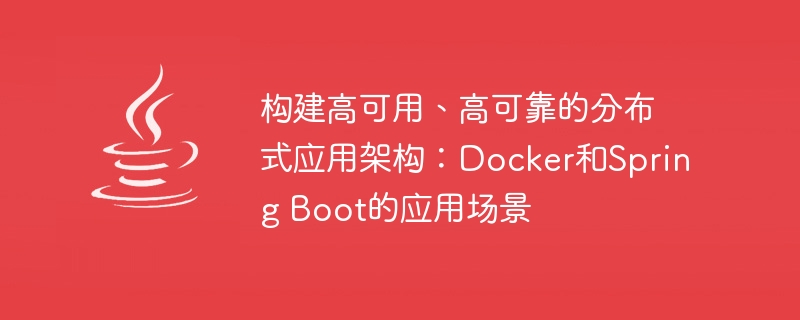

Building a highly available and highly reliable distributed application architecture: Docker and Spring Boot application scenarios require specific code examples
With the continuous development and application of Internet technology With the growth of scenario requirements, building a highly available and highly reliable distributed application architecture has become an important topic in modern software development. In this article, we will explore how to use Docker and Spring Boot to build such an application architecture, and provide some specific code examples.
First, let’s briefly introduce Docker and Spring Boot. Docker is a containerization technology that provides a lightweight, flexible and scalable deployment and running environment by packaging applications and their dependencies into portable containers. Spring Boot is a rapid development framework designed to simplify the configuration and deployment of Spring applications. It provides many out-of-the-box features such as automatic configuration, monitoring, and management.
Below, we will analyze some common application scenarios to show how to use Docker and Spring Boot to build a highly available and highly reliable distributed application architecture.
For example, we can use Spring Boot to create a simple microservice to implement user management functions. First, we can define a user model:
@Entity public class User { @Id private Long id; private String name; // getters and setters }
Then, we can create a user service to provide users with the function of adding, deleting, modifying, and checking:
@RestController public class UserController { @Autowired private UserRepository userRepository; @GetMapping("/users") public List getAllUsers() { return userRepository.findAll(); } // other methods }
Next, we can use Docker to convert this micro The service is packaged as a container. Create a file namedDockerfilein the root directory of the project with the following content:
FROM openjdk:11-jre-slim COPY target/myapp.jar /app.jar CMD ["java", "-jar", "/app.jar"]
Then, use the following command to build and run the Docker container:
docker build -t myapp . docker run -p 8080:8080 myapp
Now, Our microservices can be accessed throughhttp://localhost:8080/users. By creating and deploying additional microservices, we can build a complete distributed application.
By using Docker and Kubernetes, we can achieve features such as horizontal expansion, load balancing, and fault self-healing of applications. Here is an example of a simple Kubernetes configuration file:
apiVersion: apps/v1 kind: Deployment metadata: name: myapp spec: replicas: 3 selector: matchLabels: app: myapp template: metadata: labels: app: myapp spec: containers: - name: myapp image: myapp ports: - containerPort: 8080
Save the above configuration file asmyapp.yaml, and then use the following command to create a Replication Controller in the Kubernetes cluster:
kubectl apply -f myapp.yaml
In this way, Kubernetes will create 3 Pods to run our application and automatically manage and schedule the containers.
For Docker containers, we can use the relevant commands and APIs provided by Docker to monitor and manage the status of the container. For example, we can use the following command to check the running status of the container:
docker ps
For Spring Boot applications, we can use the endpoints provided by the Actuator module to get the health and performance metrics of the application. Enable Actuator by adding the following dependency in the pom.xml file:
org.springframework.boot spring-boot-starter-actuator
Then, add the following configuration in theapplication.propertiesfile to expose the Actuator endpoint:
management.endpoints.web.exposure.include=*
Now, we can obtain the monitoring information of the application by accessinghttp://localhost:8080/actuator.
Summary:
By using Docker and Spring Boot, we can build a highly available and highly reliable distributed application architecture. Whether it is microservice architecture, container orchestration tools or container monitoring and management, they can provide a complete set of solutions. We hope that through the code examples provided in this article, readers can better understand how to use these technologies to build distributed application architecture, and provide reference and inspiration for actual project development.
The above is the detailed content of Building a highly available and highly reliable distributed application architecture: Docker and Spring Boot application scenarios. For more information, please follow other related articles on the PHP Chinese website!
 The difference between k8s and docker
The difference between k8s and docker What is distributed
What is distributed Advantages of spring boot framework
Advantages of spring boot framework The difference between distributed and microservices
The difference between distributed and microservices What are the spring frameworks?
What are the spring frameworks? What are the methods for docker to enter the container?
What are the methods for docker to enter the container? What should I do if the docker container cannot access the external network?
What should I do if the docker container cannot access the external network? What is the use of docker image?
What is the use of docker image?



